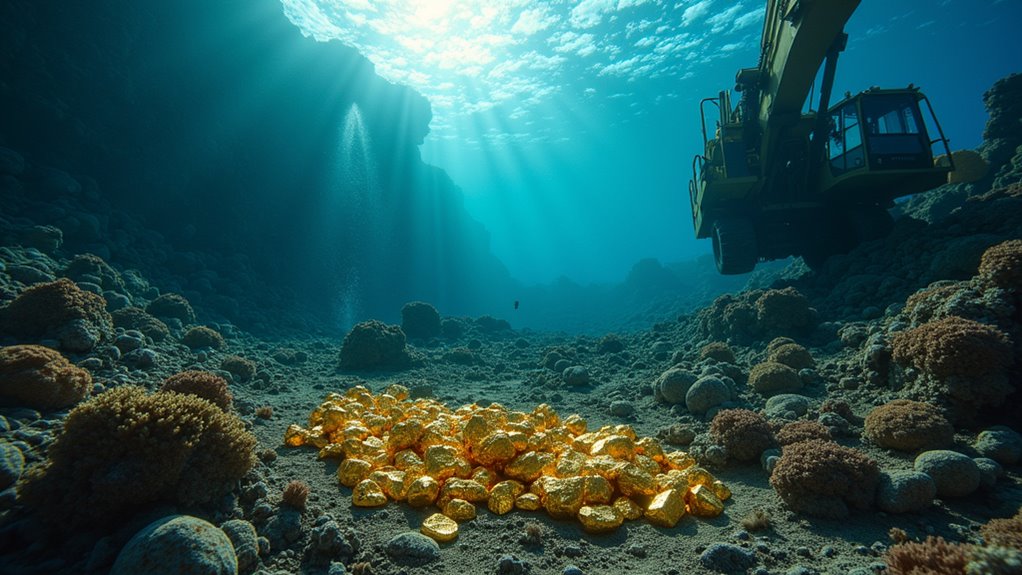Leading gold mining companies like Newmont are forecasting a gleaming future for gold, projecting production of 5.6 million ounces in 2025 amid soaring prices tipped to hit $3,700/oz by year-end, as per Goldman Sachs. They anticipate robust demand from central banks and investors, despite supply challenges and rising costs. Karat.au, with a passion for Australian gold heritage, brings clarity to these trends. Stick with us to uncover deeper insights into this golden market.
Gold Price Predictions and Market Trends

A remarkable surge in gold prices has captured global attention, with the precious metal smashing through the $3,000/oz barrier in early 2025 and soaring to new heights above $3,300/oz by April. This dazzling ascent, as reported by leading analysts like Goldman Sachs (targeting $3,700/oz by year-end), reflects gold’s unyielding allure amidst global uncertainty. The ability of gold to act as a hedge against inflation makes it even more appealing during these volatile times. Additionally, experts predict that the global economic landscape will continue to influence gold prices significantly over the next decade.
At Karat.au, we’re thrilled to unpack this for Aussies, tying it to our rich mining heritage. Economic instability, geopolitical tensions, and central bank buying—over 1,200 tonnes in 2024—fuel this rally. A weaker US dollar also makes gold cheaper for foreign buyers, boosting demand. Additionally, gold is widely recognized as a hedge against inflation, making it an attractive option for investors seeking stability.
Investor sentiment, with record ETF inflows of $21B in Q1 2025, underscores gold’s safe-haven status. Though predictions vary, with UBS eyeing $3,500/oz by December, the trend is clear: gold’s value shines brighter than ever. Historically, gold has often outperformed other assets during times of economic instability, solidifying its role in a diverse portfolio. We’re here to guide ya through this golden journey, mate!
Production Outlook and Supply Challenges

Resilience defines the global gold production landscape, yet challenges loom large on the horizon. Forecasts peg a peak of around 3,250 tonnes in 2025, before a potential 17% drop by 2030 due to reserve depletion, falling ore grades, and ageing mine closures.
Despite a modest 2.2% rise in 2024 to 131.4 million ounces, the lack of major discoveries dims long-term prospects, even as companies like Newmont guide 5.6 million ounces for 2025. Additionally, gold mining operations often lead to rainforest destruction, disrupting ecosystems and contributing to biodiversity loss, which further complicates sustainable practices in the industry. Leading companies are increasingly focusing on sustainability practices to mitigate these impacts and enhance their operational resilience. The adoption of sustainable solutions can significantly reduce the environmental footprint of gold mining operations.
At Karat.au, we see miners like Aris Mining targeting over 500k ounces post-expansion, while rising costs—Mineros forecasts AISC at $1,650-$1,750 per ounce—strain margins.
Geopolitical risks, from resource nationalism to illegal mining, further muddy the waters. Add stricter environmental rules and infrastructure woes in regions like South Africa, and it’s clear: the golden path ain’t easy.
Additionally, regional trends indicate that fluctuations in the gold market can significantly impact investment behaviors and strategies in the USA.
We’re here to unpack these complexities, celebrating Australia’s mining heritage with honest, clear insights.
Frequently Asked Questions
How Do Central Banks Influence Gold Demand?
Central banks greatly influence gold demand through their strategic reserve management. They’ve been net buyers for over 15 years, acquiring around 650 tonnes annually since 2010, with record purchases exceeding 1,000 tonnes yearly from 2022-2024.
Their actions signal confidence in gold as a safe asset, impacting market sentiment. By diversifying reserves and hedging against inflation, they create a physical floor for prices, stabilising demand even amid economic shifts.
What Drives Gold Use in Technology Sectors?
Gold’s use in technology sectors is driven by its unmatched properties, like high electrical conductivity and corrosion resistance, making it ideal for connectors, circuit boards, and wire bonding in electronics.
Demand surges with AI growth, consumer tech recovery, automotive electrification, and miniaturisation needs.
As Karat.au notes, with passion for Aussie gold heritage, electronics consume ~80% of tech gold demand (World Gold Council stats), ensuring reliability in cutting-edge devices.
How Does Jewelry Demand Affect Gold Prices?
Jewelry demand greatly influences gold prices, as it historically comprises 40-50% of global consumption.
When demand for gold jewelry rises, particularly in major markets like India and China, it often pushes prices upward due to increased buying pressure.
Conversely, high prices can dampen jewelry purchases, easing demand and potentially softening prices.
Karat.au notes this dynamic, rooted in market data, reflects gold’s delicate balance of cultural value and economic forces.
What Are Key Geopolitical Risks for Gold?
Geopolitical risks greatly impact gold prices, as global tensions drive safe-haven demand.
Wars, like the Russia-Ukraine conflict, and Middle East unrest, such as Iran-Israel tensions, create market uncertainty.
Trade disputes, including US-China tariffs, and sanctions on nations like Russia, disrupt economic stability, boosting gold’s appeal.
Karat.au notes, citing historical trends, that such crises often spike prices, though effects can be fleeting.
Gold remains a trusted hedge amidst chaos.
How Do ESG Factors Impact Mining Operations?
ESG factors greatly influence mining operations, shaping both risks and opportunities. They impact access to capital, as investors prioritise sustainability, potentially raising borrowing costs for non-compliant firms (EY).
Operationally, ESG drives innovation in renewable energy and water-saving tech, while compliance costs challenge profitability. Poor performance can harm reputation, permits, and community ties.
Yet, strong ESG practices enhance efficiency, stakeholder trust, and long-term resilience in Australia’s storied mining landscape.















